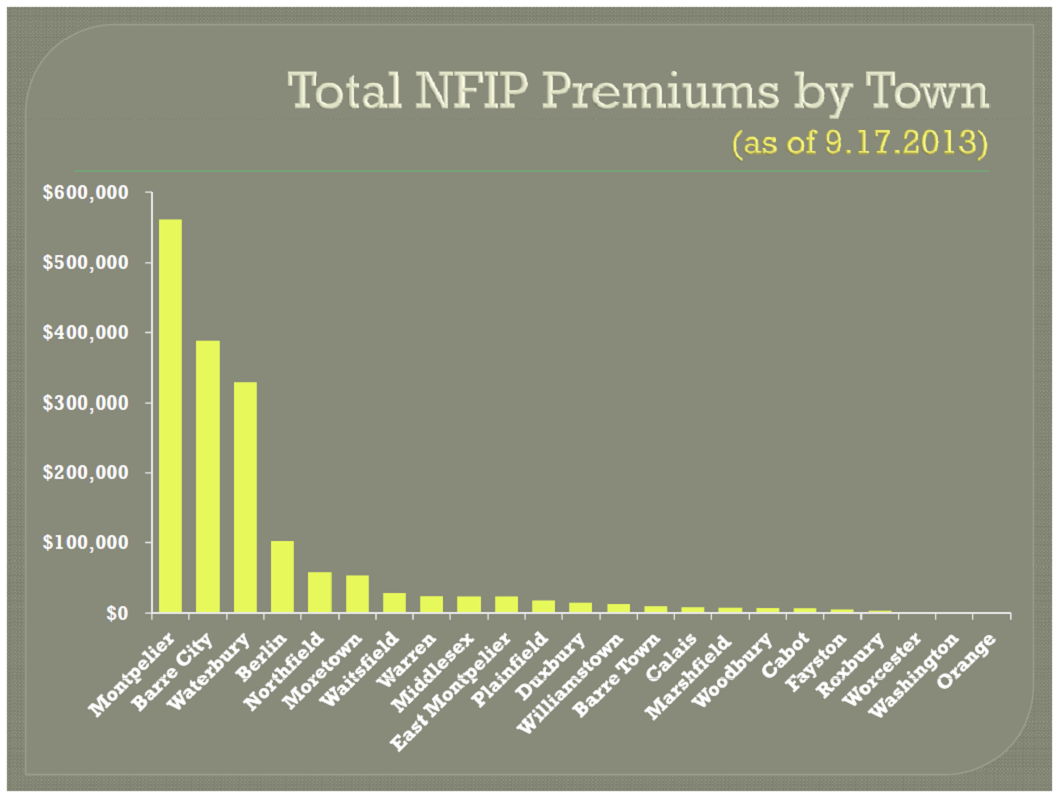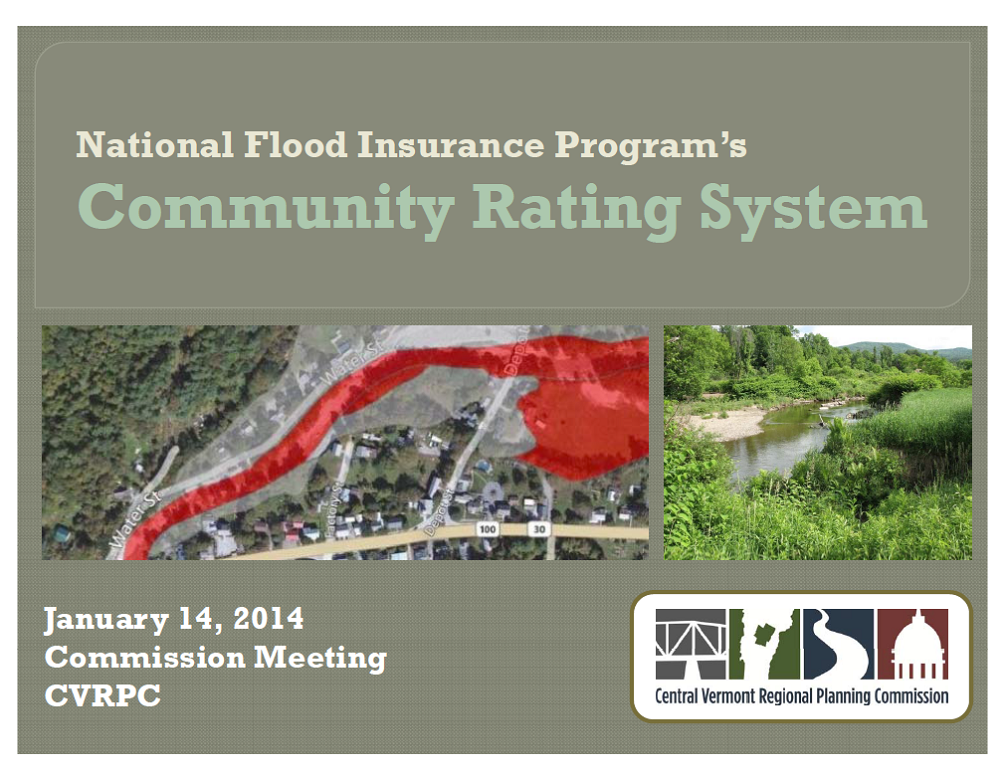Community Rating System
- What is CRS?
- How CRS Works
- Creditable CRS Activities
- How to Get Started
- Example Publications, Forms, and Resources for Creditable Activites
- Upcoming Trainings
What is CRS? Implemented in 1990, the National Flood Insurance Program’s (NFIP) Community Rating System (CRS) is a voluntary program for recognizing and encouraging community floodplain management activities that exceed the minimum NFIP standards to reduce flood losses, facilitate accurate insurance ratings and promote the awareness of flood insurance.
Download March. 2014 CVRPC CRS Presentation >>
Sign up for CRS email updates from FEMA >>
How CRS Works: CRS communities are awarded points and then rated based on their local floodplain management activities which exceed NFIP minimum requirements. The communities are then placed into categories from class 10 to class 1 based on point totals. All communities start out as a class 10 (no discount) and receive an additional 5% premium discount for each class they progress towards a class 1 (45% discount). The CRS point system is heavily weighted towards non-structural mitigation techniques, such as land use planning, zoning ordinances, open space conservation, building codes, flood warning systems, etc.
View chart of point totals and premium discounts by Class >>
Currently, Berlin, Montpelier, and Waterbury participate in CRS. Flood insurance policy holders in these communities receive a 5% discount on their insurance premiums.
Creditable CRS Activities: Classes are based on 19 creditable activities organized into four categories:
- Series 300: Public Information Activities. View poster >>
View examples and resources on CRSResources.org >>
Under this series, the CRS will credit local activities that advise people about the flood hazard, flood insurance, and flood protection measures. The activities can be directed toward floodplain residents, property owners, insurance agents, real estate attends, and others. - Series 400: Mapping and Regulations. View poster >>
View examples and resources on CRSResources.org >>
Under this series, the CRS will credit communities that enact and enforce the regulations exceeding the NFIP’s minimum standards. - Series 500: Flood Damage Reduction . View poster >>
View examples and resources on CRSResources.org >>
Under this series, the CRS will credit communities that focus on reducing flood damage to existing buildings. Recognized damage reduction measures include acquiring, relocating or retrofitting existing buildings; maintaining and improving drainage systems; and planning for the best way to implement these and other loss prevention and reduction activities. - Series 600: Flood Preparedness. View poster >>
View examples and resources on CRSResources.org >>
Under this series, the CRS will credit communities that recognize the importance of effective flood warning and response in a comprehensive floodplain management program.
How to Get Started: A community can request a CRS classification at any time, provided that the community can meet all the required responsibilities and credit points add up to at least 500 points (done using CRS Quick Check spreadsheet – download >> ).
Available Resources:
- Download a CRS Factsheet >>
- Visit CRSResources.org >>
- Download the CRS Quick Check and Quick Check Instructions >>
- Download the full 2013 CRS Coordinator’s Manual >>
Example Publications, Forms, and Resources for Creditable Activites
General Information
2013 Verification Checklists >>
Uniform Minimum Credit in Vermont >>
Public Information
310 Elevation Certificate >> – How to complete for CRS
320 Map Information Memo to Real Estate Professionals >> example
320 Map Floodplain Information Requests – Letter to Residents >> example
320 Mailing Addresses and Contact Info for Central Vermont Realtors >>
320 Mailing Addresses and Contact Info for Central Vermont Flood Insurance Agents >>
330 Program for Public Information – Miles City >> example
330 Program for Public Information – Pasadena, TX >> example
330 Miles City Mailer >> example
330 Montpelier Flood Leaflet >> example
330 Letter to Residents re: Flood Insurance >> example
330 Letter to Residents re: Flood Insurance >> Montpelier VT example
340 Request to Realtors >> example
340 Template for Real estate agents’ brochure >> example
350 Letter from Librarian >> example
350 FEMA Publication Order Form Template >>
350 Flood-related Information on Web Site – City of Montpelier, VT >> example
350 Flood-related Information on Web Site – Snohomish County, WA >> example
350 Flood Related Information on Web Site – Calumet City, IL >> example
360 Local Floodproofing Programs >>
360 Flood Protection Assistance Log >>
Mapping and Regulations
420 Natural Floodplain Functions Form >>
420 Open Space Verification Letter >>
430 Higher Regulatory Standards – Vermont Model Flood Hazard Regulations 4 >>
Model Ordinance 4 includes a summary table outlining the activities prohibited in the floodplain (Table 1). If Model Ordinance 4 is implemented, then CRS credits are potentially available for freeboard, cumulative substantial improvements, protection for critical facilities, protection of floodplain storage capacity, natural and beneficial functions, enclosure limits, other higher standards, land development criteria, special hazards regulations, staffing, and manufactured home parks. See Uniform Minimum Credit in Vermont for summary of potential credit points.
430 Freeboard Credit and Ductwork >>
440 Vermont ANR Natural Resource Atlas >>
Floodplain Damage Reduction
510 Adopted Local Hazard Mitigation Plans in Central Vermont >>
540 Drainage System Maintenance Handout 2013 >>
Flood Warning and Response
610 Flood Warning and Response Documentation Checklist >>
630 Dams Documentation Checklist >>
- Free online STARR (Strategic Alliance for Risk Reduction) Trainings: click here, then click on “Upcoming” tab for schedule & signups >>
- Upcoming trainings at FEMA’s Emergency Management Institute: Trainings are free for municipal staff, only meal ticket not covered by FEMA.
Total NFIP Premiums by Central Vermont community (as of 9.17.2013)

To view updated data, visit VT ANR’s FloodReadyVT web site >>
For more information: Contact Brian Voigt at voigt@cvregion.com, 802-229-0389, or the State NFIP Coordinator Rebecca Pfeiffer at Rebecca.Pfeiffer@state.vt.us.

